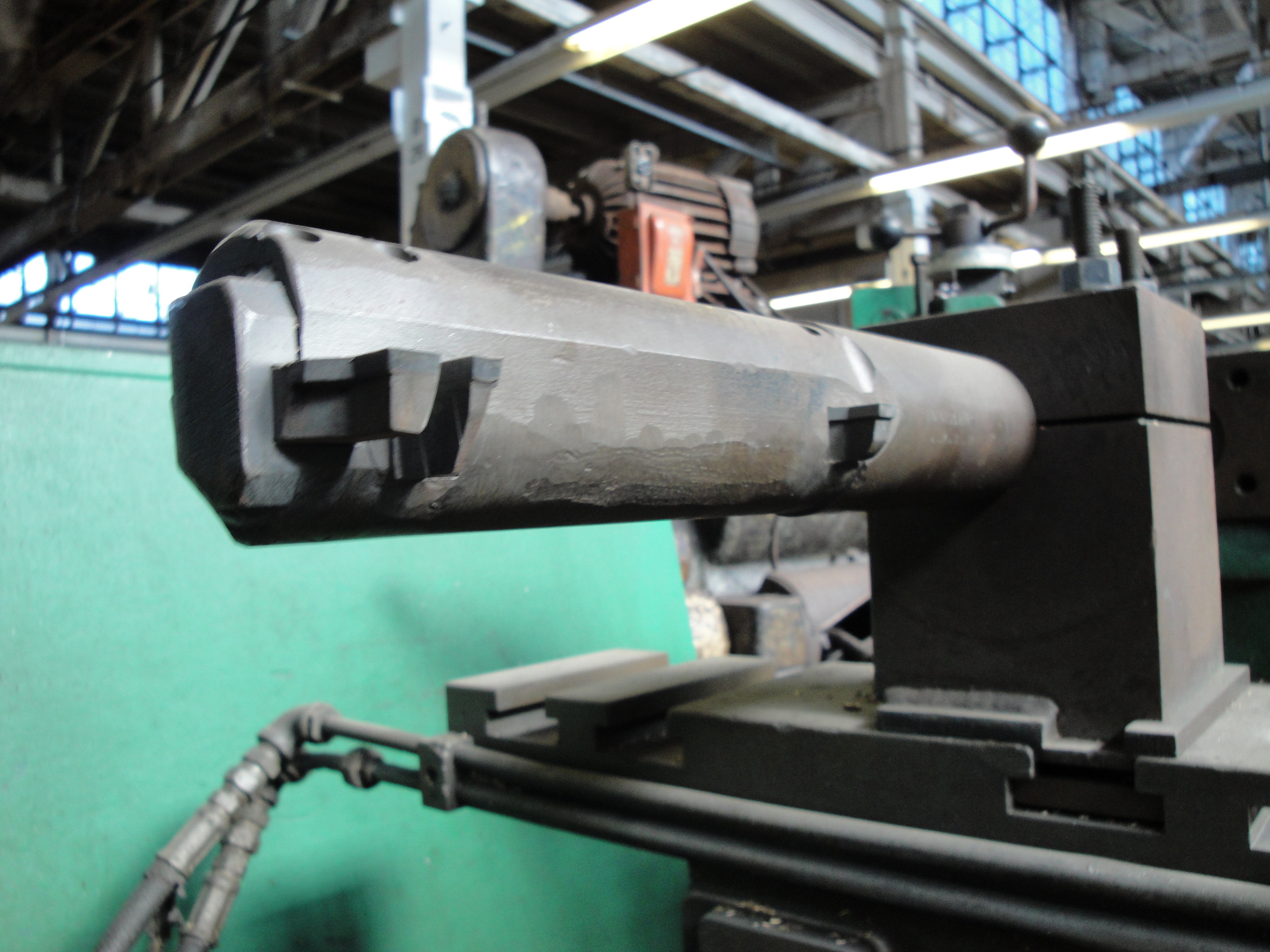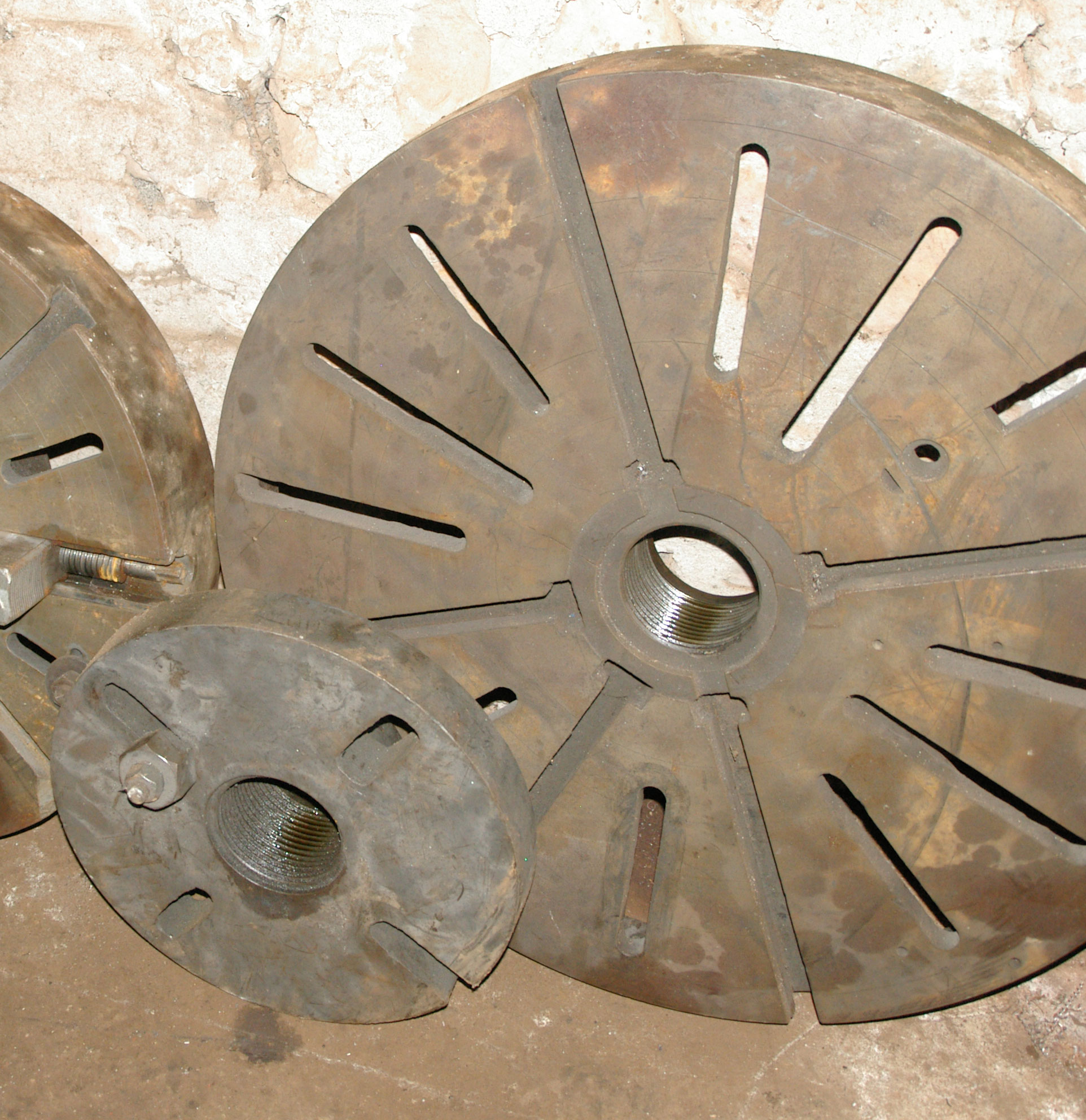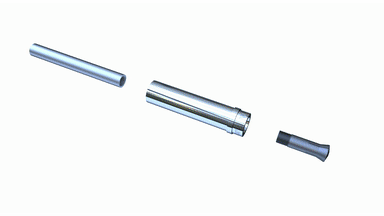|
Boring (manufacturing)
In machining, boring is the process of enlarging a hole that has already been drilled (or casting, cast) by means of a Tool bit, single-point cutting tool (or of a boring head containing several such tools), such as in boring a gun barrel or an cylinder (engine), engine cylinder. Boring is used to achieve greater accuracy of the diameter of a hole, and can be used to cut a tapered hole. Boring can be viewed as the internal-diameter counterpart to turning, which cuts external diameters. There are various types of boring. The boring bar may be supported on both ends (which only works if the existing hole is a through hole), or it may be supported at one end (which works for both, through holes and blind holes). Lineboring (line boring, line-boring) implies the former. Backboring (back boring, back-boring) is the process of reaching through an existing hole and then boring on the "back" side of the workpiece (relative to the machine headstock). Because of the limitatio ... [...More Info...] [...Related Items...] OR: [Wikipedia] [Google] [Baidu] |
Boring Bar 001
Boring may refer to: *Something that causes boredom Engineering and science * Boring (earth), drilling a hole, tunnel, or well in the earth ** Tunnel boring machine, a machine used in boring tunnels * Boring (manufacturing), enlarging a hole that has already been drilled * Drilling, a cutting process that uses a drill bit to cut a hole of circular cross-section * Boring, a mechanism of bioerosion Places * Boring, Maryland, U.S. * Boring, Oregon, U.S. ** Boring Lava Field * Boring, Tennessee, U.S. Other uses * Boring (surname) * Boring (The Young Ones), "Boring" (''The Young Ones''), an episode of ''The Young Ones'' * "Boring", a song by Pink from ''Funhouse (Pink album), Funhouse'' * "Boring (It's Too Late)", a song by Medina from ''Forever (Medina album), Forever'' * The Boring Company See also * * Bore (other) * Bored (other) * Boredom (other) * Boreing (other) * Drilling (other) * Earth-boring dung beetle, a family of beetle ... [...More Info...] [...Related Items...] OR: [Wikipedia] [Google] [Baidu] |
Milling Machine
Milling is the process of machining using rotary cutters to remove material by advancing a cutter into a workpiece. This may be done by varying directions on one or several axes, cutter head speed, and pressure. Milling covers a wide variety of different operations and machines, on scales from small individual parts to large, heavy-duty gang milling operations. It is one of the most commonly used processes for machining custom parts to precise tolerances. Milling can be done with a wide range of machine tools. The original class of machine tools for milling was the milling machine (often called a mill). After the advent of computer numerical control (CNC) in the 1960s, milling machines evolved into ''machining centers'': milling machines augmented by automatic tool changers, tool magazines or carousels, CNC capability, coolant systems, and enclosures. Milling centers are generally classified as vertical machining centers (VMCs) or horizontal machining centers (HMCs). The integr ... [...More Info...] [...Related Items...] OR: [Wikipedia] [Google] [Baidu] |
Lathe Faceplate
A lathe faceplate is a basic workholding accessory for a wood or metal turning lathe. It is a circular metal (usually cast iron) plate which fixes to the end of the lathe spindle (tool), spindle. The workpiece is then clamped to the faceplate, typically using t-slot nuts in slots in the faceplate, or less commonly threaded holes in the faceplate itself. The faceplate may be attached to the lathe in several ways: the two most common are a thread and a precision cone arrangement, and threaded studs and a circular recess fitting a flange on the end of the spindle. Increasingly common is the cam lock (latch), camlock arrangement, in which shaped studs and cams replace threaded studs for rapid exchanging of the faceplate with other accessories, such as Chuck (engineering)#Three-jaw, three or four jaw chucks. The faceplate was the ancestor of lathe chucks, an arrangement of three or more adjustable 'dogs' bolted to the faceplate providing a primitive chuck arrangement. The smaller pla ... [...More Info...] [...Related Items...] OR: [Wikipedia] [Google] [Baidu] |
Collet
A collet is a segmented sleeve, band or ''collar''. One of the two radial surfaces of a collet is usually tapered (i.e a truncated cone) and the other is cylindrical. The term ''collet'' commonly refers to a type of chuck that uses collets to hold either a workpiece or a tool (such as a drill), but collets have other mechanical applications. An external collet is a sleeve with a cylindrical inner surface and a conical outer surface. The collet can be squeezed against a matching taper such that its inner surface contracts to a slightly smaller diameter, squeezing the tool or workpiece to hold it securely. Most often the collet is made of spring steel, with one or more kerf cuts along its length to allow it to expand and contract. This type of collet holds the external surface of the tool or workpiece being clamped. This is the most usual type of collet chuck. An external collet clamps against the internal surface or bore of a hollow cylinder. The collet's taper is int ... [...More Info...] [...Related Items...] OR: [Wikipedia] [Google] [Baidu] |
Single-point Cutting Tool
In machining, a tool bit is a non-rotary cutting tool used in Lathe (metal), metal lathes, shapers, and Planer (metalworking), planers. Such cutters are also often referred to by the set-phrase name of single-point cutting tool, as distinguished from other cutting tools such as a saw or water jet cutter. The Blade, cutting edge is ground to suit a particular machining operation and may be resharpened or reshaped as needed. The ground tool bit is held rigidly by a tool holder while it is cutting. Geometry Rake angle, Back rake is to help control the direction of the chip, which naturally curves into the work due to the difference in length from the outer and inner parts of the cut. It also helps counteract the pressure against the tool from the work by pulling the tool into the work. Side rake along with back rake controls the chip flow and partly counteracts the resistance of the work to the movement of the cutter and can be optimized to suit the particular material being cu ... [...More Info...] [...Related Items...] OR: [Wikipedia] [Google] [Baidu] |
G-code
G-code (abbreviation for geometric code; also called RS-274, standardized today in ISO 6983-1) is the most widely used computer numerical control (CNC) and 3D printing programming language. It is used mainly in computer-aided manufacturing to control automated machine tools, as well as for 3D-printer slicer applications. G-code has many variants. G-code instructions are provided to a machine controller (industrial computer) that tells the motors where to move, how fast to move, and what path to follow. The two most common situations are that, within a machine tool such as a lathe or mill, a cutting tool is moved according to these instructions through a toolpath cutting away material to leave only the finished workpiece and/or an unfinished workpiece is precisely positioned in any of up to nine axes around the three dimensions relative to a toolpath and, either or both can move relative to each other. The same concept also extends to noncutting tools such as forming or b ... [...More Info...] [...Related Items...] OR: [Wikipedia] [Google] [Baidu] |
Subroutine
In computer programming, a function (also procedure, method, subroutine, routine, or subprogram) is a callable unit of software logic that has a well-defined interface and behavior and can be invoked multiple times. Callable units provide a powerful programming tool. The primary purpose is to allow for the decomposition of a large and/or complicated problem into chunks that have relatively low cognitive load and to assign the chunks meaningful names (unless they are anonymous). Judicious application can reduce the cost of developing and maintaining software, while increasing its quality and reliability. Callable units are present at multiple levels of abstraction in the programming environment. For example, a programmer may write a function in source code that is compiled to machine code that implements similar semantics. There is a callable unit in the source code and an associated one in the machine code, but they are different kinds of callable units with different impl ... [...More Info...] [...Related Items...] OR: [Wikipedia] [Google] [Baidu] |
Gun Drill
Gun drills (through coolant drill) are straight fluted drills which allow cutting fluid (either compressed air or a suitable liquid) to be injected through the drill's hollow body to the cutting face. They are used for deep hole drilling—a depth-to-diameter ratio of 300:1 or more is possible. Gun barrels are the obvious example; hence the name. Application Uses include moldmaking, diemaking, and the manufacture of combustion engine parts such as crankcase, cylinder head, and woodwind musical instruments, such as uilleann pipes, as gun drills can drill long straight holes in metal, wood, and some plastics. The coolant provides lubrication and cooling to the cutting edges and removes the swarf or chips from the hole. Modern gun drills use carbide tips to prolong life and reduce total cost when compared with steel tips. Speed of drilling depends on the material being drilled, rotational speed, and the drill diameter; a high speed drill can cut a hole in P20 steel ... [...More Info...] [...Related Items...] OR: [Wikipedia] [Google] [Baidu] |
Cutting Fluid
Cutting fluid is a type of coolant and lubricant designed specifically for metalworking processes, such as machining and stamping. There are various kinds of cutting fluids, which include oils, oil-water emulsions, pastes, gels, aerosols (mists), and air or other gases. Cutting fluids are made from petroleum distillates, animal fats, plant oils, water and air, or other raw ingredients. Depending on context and on which type of cutting fluid is being considered, it may be referred to as cutting fluid, cutting oil, cutting compound, coolant, or lubricant. Most metalworking and machining processes can benefit from the use of cutting fluid, depending on workpiece material. Common exceptions to this are cast iron and brass, which may be machined dry (though this is not true of all brasses, and any machining of brass will likely benefit from the presence of a cutting fluid). The properties that are sought after in a good cutting fluid are the ability to: * Keep the workpiece at a s ... [...More Info...] [...Related Items...] OR: [Wikipedia] [Google] [Baidu] |
Drilling
Drilling is a cutting process where a drill bit is spun to cut a hole of circular cross section (geometry), cross-section in solid materials. The drill bit is usually a rotary Cutting tool (machining), cutting tool, often multi-point. The bit is Pressure, pressed against the work-piece and rotated at rates from hundreds to thousands of revolutions per minute. This forces the cutting edge against the work-piece, cutting off Swarf, chips (swarf) from the hole as it is drilled. In Rock (geology), rock drilling, the hole is usually not made through a circular cutting motion, though the bit is usually rotated. Instead, the hole is usually made by hammering a drill bit into the hole with quickly repeated short movements. The hammering action can be performed from outside the hole (top-hammer drill) or within the hole (down-the-hole drill, DTH). Drills used for horizontal drilling are called drifter drills. In rare cases, specially-shaped bits are used to cut holes of non-circular cro ... [...More Info...] [...Related Items...] OR: [Wikipedia] [Google] [Baidu] |
Cemented Carbide
Cemented carbides are a class of hard materials used extensively for cutting tool material, cutting tools, as well as in other industrial applications. It consists of fine particles of carbide cemented into a composite material, composite by a binder metal. Cemented carbides commonly use tungsten carbide (WC), titanium carbide (TiC), or tantalum carbide (TaC) as the aggregate. Mentions of "carbide" or "tungsten carbide" in industrial contexts usually refer to these cemented composites. Most of the time, carbide cutters will leave a better surface finish on a part and allow for speeds and feeds, faster machining than high-speed steel or other tool steels. Carbide tools can withstand higher temperatures at the cutter-workpiece interface than standard high-speed steel tools (which is a principal reason enabling the faster machining). Carbide is usually superior for the cutting of tough materials such as carbon steel or stainless steel, as well as in situations where other cutting t ... [...More Info...] [...Related Items...] OR: [Wikipedia] [Google] [Baidu] |
High-speed Steel
High-speed steel (HSS or HS) is a subset of tool steels, commonly used as cutting tool material. Compared to high- carbon steel tools, high-speed steels can withstand higher temperatures without losing their temper (hardness), allowing use of faster cutting speeds. At room temperature, in their generally recommended heat treatment, HSS grades generally display high hardness (above 60 Rockwell C) and abrasion resistance compared with common carbon and tool steels. There are several different types of high speed steel, such as M42 and M2. History In 1868, English metallurgist Robert Forester Mushet developed Mushet steel, considered the forerunner of modern high-speed steels. It consisted of 2% carbon, 2.5% manganese, and 7% tungsten. The major advantage of this steel was that it hardened when air cooled from a temperature at which most steels had to be quenched for hardening. Over the next 30 years, the most significant change was the replacement of manganese with ... [...More Info...] [...Related Items...] OR: [Wikipedia] [Google] [Baidu] |






